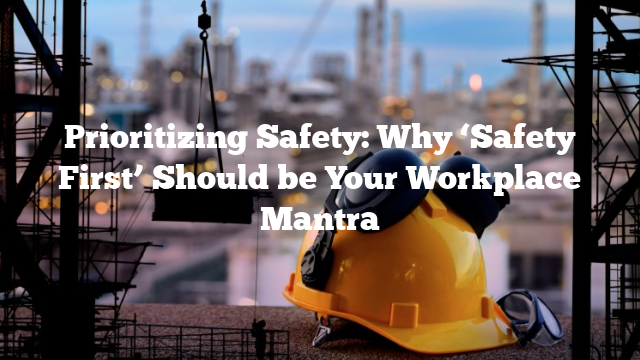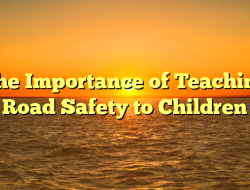Introduction:
When it comes to ensuring safety in our daily lives, the phrase “safety first” couldn’t be more relevant. Whether it’s in the workplace, while driving, or at home, safety should always be at the top of our minds. In fact, the term “safety first” has become a commonly used phrase to remind us of the importance of prioritizing safety over anything else.
However, the phrase “safety first” goes beyond just a reminder. It is a mindset that should be adopted in all aspects of our lives. In this article, we will explore what “safety first” means, why it is important, and how we can implement it in different areas of our lives. Let’s dive in!
What is “safety first”?
“Safety first” is a mindset that puts safety as the top priority in any situation. It means taking necessary precautions, following safety protocols, and being aware of potential hazards. This mindset is especially important in high-risk environments such as construction sites, chemical plants, or healthcare facilities.
Moreover, “safety first” is not limited to just these high-risk environments. It is equally important in our daily lives, whether it’s at home, while driving, or even while walking on the street. Adopting a safety-first mindset means being proactive in identifying potential hazards and taking steps to prevent accidents.
Why is “safety first” important?
The importance of “safety first” cannot be overstated. According to the National Safety Council, unintentional injuries are the third leading cause of death in the United States. These injuries can occur at any time and in any place, from slipping on a wet floor to a serious car accident.
Moreover, accidents can cause not only physical harm but also emotional and financial damage. Injuries can result in expensive medical bills, lost wages, and even long-term disabilities. Therefore, adopting a safety-first mindset can help prevent accidents and ultimately save lives.
Facts about “safety first”
– The “safety first” concept was first introduced in the early 20th century by the National Safety Council.
– In 2019, there were over 39 million injury-related visits to emergency rooms in the United States.
– The construction industry has the highest rate of fatal work injuries, with 1 in 5 worker deaths occurring in this industry.
– In 2019, there were over 36,000 deaths caused by motor vehicle accidents in the United States.
Tutorial of “safety first”
Adopting a safety-first mindset is not difficult, but it does require a conscious effort. Here are some steps you can take to prioritize safety in your daily life:
Step 1: Identify potential hazards
The first step in adopting a safety-first mindset is to identify potential hazards. This can be anything from a wet floor to a faulty electrical outlet. Once you identify these hazards, take steps to eliminate them or minimize the risk.
Step 2: Follow safety protocols
Whether it’s at work or in your personal life, following safety protocols is crucial. This includes wearing personal protective equipment such as helmets or safety glasses, following traffic rules while driving, or using caution when handling hazardous materials.
Step 3: Stay informed
Keeping up-to-date with safety regulations and guidelines is essential in maintaining a safety-first mindset. Attend safety training sessions and read safety manuals to stay informed about potential hazards and how to prevent them.
Tips for “safety first”
Here are some additional tips to keep in mind when adopting a safety-first mindset:
1. Always wear personal protective equipment when necessary, such as helmets, safety glasses, or gloves.
2. Be aware of your surroundings and potential hazards in your environment.
3. Take breaks when needed, especially if you’re feeling fatigued or stressed.
4. Follow traffic rules and practice defensive driving techniques.
5. In case of an emergency, remain calm and follow the appropriate protocols.
Question and Answer of “safety first”
Q: What are some common hazards in the workplace?
A: Common hazards in the workplace include falls, electrical hazards, and exposure to hazardous materials.
Q: How can I ensure safety while driving?
A: You can ensure safety while driving by following traffic rules, wearing a seatbelt, and avoiding distractions such as texting while driving.
Q: What should I do in case of a workplace emergency?
A: In case of a workplace emergency, remain calm and follow the appropriate protocols. This may include evacuating the building or seeking medical attention.
Q: How can I encourage a safety-first mindset in my workplace?
A: You can encourage a safety-first mindset in your workplace by providing safety training, enforcing safety protocols, and promoting a culture of safety.
Conclusion of “safety first”
In conclusion, adopting a safety-first mindset is crucial in ensuring our well-being and preventing accidents. Whether it’s at work, while driving, or at home, prioritizing safety should always be our top priority. By following safety protocols, identifying potential hazards, and staying informed, we can create a safer and healthier environment for ourselves and those around us. Remember, safety first!
Recommendations:
- Safety Plan Worksheet For Adults It is important that the safety plan worksheet is completed with the therapist and patient working together. 1 feeling safe being safe ety in an gency. Safety Plan Worksheet Therapist…
- Safety Slogans For Drivers A harness is better than a hearse. If you know you are driving to your death would you still drive so fast. Funny 76 Road Safety Slogans And Posters Road…
- Monthly Safety Inspection Form Observed form is provided to document that the hazard was reported. Here are some of the ways inspections can take place. B8 Monthly Crib Safety Inspection Form Includes checks for…
- Safety First Slogan One of the major ways. 167 catchy and funny safety slogans for workplaces 2020 find the best catchy safety slogans for your workplace stop press. Labels Safety Slogans A big…
- Safety Meeting Topics Fresh ideas for tailgate meetings or safety moments at work. Safety toolbox talks was started in 2007 as a portal for safety professionals to share and exchange free safety topic…
- Vehicle Safety Inspection Checklist When do i need a vehicle inspection checklist template. Missouris motor vehicle safety inspection program requires each vehicle for professional or personal use to go through a series of checks…
- Catchy Safety Slogans For The Workplace In this post we are going to share with you a list of 57 funny safety slogans. Here are best safety slogans for workplace. 201 Catchy Safety Slogans For The…
- Safety Shoes Supplier Being one of the leading industrial safety footwear manufacturers and supplier in europe and asia. The safety shoes of bata industrials are designed to fit well look good and get…
- Weekly Safety Inspection Checklist Are all employees trained in hazardous substances safety. Access all your safety inspection checklists and forms from your mobile and never worry about losing a piece of paper again. Ultimate…
- Safety First Images Download 15297 safety first stock photos for free or amazingly low rates. Affordable and search from millions of royalty free images photos and vectors. Safety First Logo On White Background…
- Workplace Safety Slogans Images Researchers reveal the top 10 most effective safety slogans ever click here. 167 catchy and funny safety slogans for workplaces 2020 find the best catchy safety slogans for your workplace…
- Food Safety Inspection Checklist Template Food safety checklists templates. You can access our templates below. Vehicle Safety Inspection Checklist Form Car Maintenance Tips Food safety checklists form the basis for a food safety system and…
- Huge Safety Slogans Complete List Made Your Safety… Browse through the safety slogans in 2022 suggestions below. The safety slogans is one of Safety Communication method which successful of safety campaign was measured. So Safety Slogans is so…
- Safety Logo Icon 9652 best safety free vector art downloads from the vecteezy community. All icons are available in svg eps png psd format and as icon font. Worker Hat Safety Icon Royalty…
- Vehicle Safety Inspection Form I cant find it anywhere on the website or through the app to download and p. This form must be filled up by the driver which will serve as a…
- Site Safety Inspection Checklist They will give you some indication of where you should begin action. Weekly site safety inspection checklist. Jobsite Safety Inspection Checklist Mcaa Place next to each item that is satisfactoryplace…
- Driving Safety Topics Injury should never be a cost of doing business. Get the right safety moment or safety meeting topic for your next tool box talk. 15 Of The Most Forgotten Driving…
- Car Safety Inspection Checklist Checklist for safety inspection fill online printable fillable. Present the certificate of inspection marked. Vehicle Safety Inspection Checklist Form Vehicle Vehicle You will know whether your vehicle is due for…
- Safety Quotes Funny Try being a little creative and your message gets across. A big thank you to all of our readers who have contributed some excellent. Funny Workplace Safety Pictures Safety Slogans…
- Poster On Road Safety Tips Safety road trip and people concept happy. Find and save ideas about road safety poster on pinterest. 14 Best Road Safety Poster Images In 2017 Road Safety Poster Dont Road…
- Office Safety Meeting Topics Tool box talks safety moments and pre start meetings have become a very effective way of maintaining safety awareness and bringing attention to any current or emerging hazards and risks.…
- Safety Inspection Checklist Template It covers the owner and vehicle details including the complete name of the vehicle owner home address email club membership if there is model chassis no engine no make year…
- Workplace Safety Inspection Checklist Template Use our professionally designed workplace safety inspection checklist template that you can download instantly. After you have used it a couple of times you may wish to modify it so…
- Safety Inspection Report Template In line with this we have here safety report templates that you can download and use. Neglecting such reports could bring out legal and administrative consequences. Safety Report Templates 16…
- Safety Slogans For Workplace Safety is the key to life dont get locked out. The wishbone will never replace the backbone. 201 Catchy Safety Slogans For The Workplace Safety Slogans Summer safety slogan put…
- Safety Inspection Sheet Self inspection is necessary if you are to know where probable hazards exist and whether they are under control. This form is not to be used for inspections of mobileoverhead…
- Funny Electrical Safety Posters Top ten funny electrical shorts an electrical joke funny electrical safety cartoon terrifying electrics funny health and safety pictures safety powerpoint presentation sponsored links electrical safety pictures lightning nearly. People…
- Safety First Baby Gate More buying choices 1431 7 used new offers summer top of stairs simple to secure metal gate white 29 42 inch wide. The safety 1 st lift lock swing gate…
- Safety Quotes For The Workplace Funny In this post we are going to share with you a list of 57 funny safety slogans. Researchers reveal the top 10 most effective safety slogans ever click here. Funny…
- Safety Slogans In English 10 toes if you are not safe who knows. To start with a road safety campaign it is very important to have a proper slogan on road safety. My Top…
Advertisement
Scroll to Continue With Content




